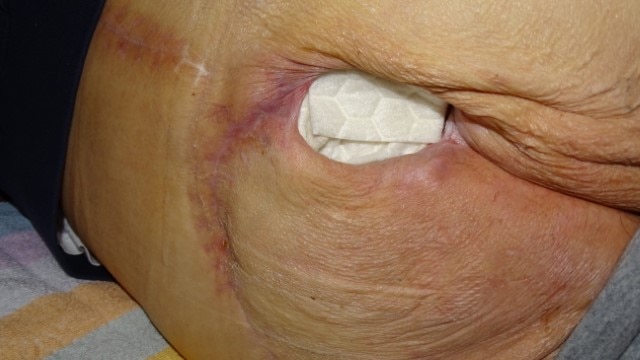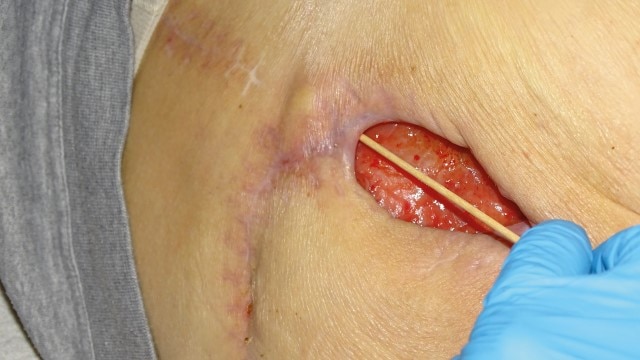Get full access with a free account
Benefits of the Coloplast® Professional Educational platform
Get full access to all educational content, events and resources
Track your progress
Share content with your collegues
Share supporting material with your patient
How to use gelling fibre dressings
In this section, you’ll learn all about:
How should I use a gelling fibre dressing?
Whenyou use a gelling fibre dressing, you should follow these four main steps.
Step 1: Start with a holistic wound assessment
As a part of your assessment, you should look at the wound’s:
- depth;
- undermining;
- tunnelling;
- fistulas; and
- exudate.
This will give you the information you need to choose the right dressing for the wound.
TIP: The Triangle of Wound Assessment is a useful tool that can help you conduct a more holistic assessment, taking into consideration the patient’s general state of health and well-being as well as condition of the wound itself. You can read more about this assessment tool here.

Step 2: Use the gelling fibre dressing as the primary dressing
Gelling fibre dressings are primary dressings. They are designed to be in direct contact with the wound bed. You can choose between a flat sheet for a shallow wound, or a rope for wounds with deeper cavities. You can also use a combination of a flat sheet and a rope.3 You should select a size that fits the wound and cut if necessary.
When you use a gelling fibre dressing on a deep or cavity wound, your goal should be to fill the entire wound cavity with the gelling fibre. Gently press the dressing in place, making sure to fill in any tunnels or undermining in the wound. This will help you avoid a gap between the dressing and the wound bed.
To see how to use a gelling fibre dressing, watch this video.
TIP: For gelling fibre dressings to work optimally, they need to cover the wound bed surface. The greater the area of the wound bed surface that is in direct contact with the gelling fibre dressing, the better the dressing will be able to absorb the exudate and avoid pooling.3 You also want to make sure the secondary dressing stays in contact with the gelling fibre dressing.4
Step 3: Apply the secondary dressing as needed
The type of secondary dressing you choose will depend on the wound. In wounds that have high amounts of exudate, you might choose to use a silicone foam dressing as the secondary dressing. This could provide additional vertical absorption.
Step 4: Assess the wound and dressing at each dressing change
Each dressing change gives you the opportunity to assess the wound and the dressing. By examining the dressing, you can see how it’s performing and examine the exudate.1
To learn more about what to look for when you’re changing the dressing, visit the exudate management section.

When should I use a gelling fibre dressing?
Gelling fibre dressings are used for:
- moderately to highly exuding acute and chronic wounds;
- cavity wounds;
- sloughy wounds; and
- wounds with undermining.3
How do I select the right gelling fibre dressing?
Ina recent survey, clinicians identified three key criteria that are important when selecting a gelling fibre dressing:
- absorption;
- minimal shrinkage; and
- cohesion4
Let’s take a closer look at each of these criteria.
![]() Absorption
Absorption
To be effective, the gelling fibres need to absorb and retain exudate. If they don't, this could lead to maceration.4 The wound’s position can affect how well a gelling fibre dressing absorbs exudate.5 Wounds with high exudate levels have a greater chance of leaking through the lower part of the dressing due to gravity. With leg injuries, the distal (or lower) part of the wound and periwound skin are particularly in danger. That’s why it’s important that the gelling fibre dressing can absorb exudate, even when the wound is in a vertical position.4
![]() Minimal shrinkage
Minimal shrinkage
Gelling fibre dressings are designed for wounds with moderate to high exudate levels. However, some gelling fibre dressings shrink by up to 37% when wet.3 Shrinkage of the dressing may create a gap between the wound bed and the dressing, especially in wounds with deep cavities.3 So, it’s important that you select a gelling fibre dressing that has minimal surface shrinkage. This will help you ensure that the dressing stays in close contact with the wound bed.
![]() Cohesion
Cohesion
Gelling fibre dressings are made up of synthetic materials. These materials are non-biodegradable, so they need to be completely removed from the body. While this may not be an issue if the wound is shallow, you will need to keep this in mind with deeper or cavity wounds.3
In cavity wounds, you also need to use more force to remove the dressing. And you may not always be able to see if you’ve removed everything. If gelling fibres don’t maintain their strength when wet, they can break apart when you’re removing them. This can leave debris or residue behind in the wound. It can also take you longer to perform a dressing change.4
That’s why it’s important to select a gelling fibre dressing that is easy to remove in one piece without leaving residue in the wound bed.3
Summary:
Three tips for choosing the right gelling fibre dressing
When you choose a gelling fibre dressing, make sure:
- it absorbs and retains large amounts of exudate;
- it has minimal surface shrinkage; and
- it’s easy to remove in one piece and that it doesn’t leave residue in the wound bed.
References
- World Union of Wound Healing Societies (WUWHS), Consensus Document. Wound exudate: effective assessment and management. Wounds International, 2019
- Gelling Fiber Wound Dressings – WoundSource. https://www.woundsource.com/product-category/dressings/gelling-fiber-dressings
- NHS Clinical Review: Gelling Fibre Dressings (V2) 01.2018
- Tonny Karlsmark et. al. A new reinforced gelling fibre to reduce exudate pooling, Wounds International, vol 3. 2020
